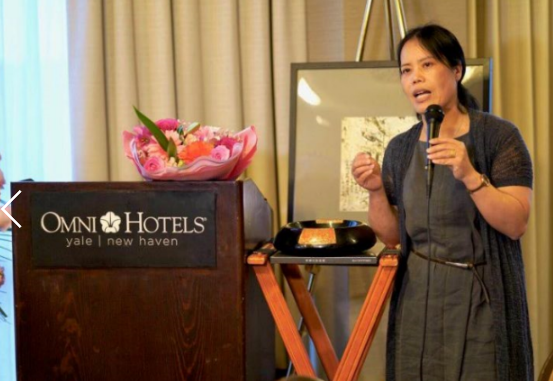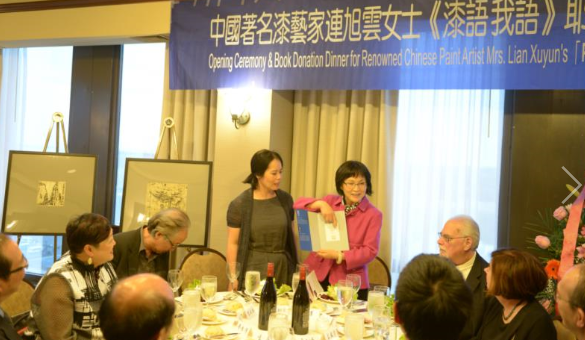
Lian Xuyun discusses her work and Chinese lacquer art on May 27, 2018.
New York (People's Daily) – “China is not only the motherland of porcelain but also the home of silk and lacquerware. The invention and use of lacquerware is an outstanding contribution from the Chinese to human civilization,” said Chinese lacquer artist Lian Xuyun at the launch for Lacquer Painting Words and My Words – Lian Xuyun Collection, at Yale University, New Haven, Connecticut on Monday.
Chinese lacquer art represents the quintessence of human civilization and is a living fossil of human art. According to historical records, China was the first country to use lacquer. Red lacquer wooden bowls dating back more than 7,000 years from the Zhejiang Hemudu Cultural Relics Site, and a lacquer bow dating back some 8,000 years at the Zhejiang cross-lake Bridge Site, are some of the earliest recorded lacquer work.
For more than 8,000 years, Chinese lacquer has possessed profound cultural connotations and aesthetic value because of its unique cultural perspective and use of vivid language. As a means of culture inheritance, lacquer has never stopped developing and has an innovative history. It has since become an independent art form.
“My first lacquer artwork was completed in 2000. The ancient and primitive lacquer is also referred to as natural lacquer, raw lacquer, national lacquer, but most widely known as Chinese lacquer,” said Lian.

Lian Xuyun (left) is the leading expert on Chinese laquer art.
When a lacquer tree is between the ages of seven and eight, their bark is removed and a kind of white viscose latex flows outward and can be processed into paint. Chinese lacquer provides an aesthetic support within its material and is an artistic creation. It is generally called “lacquer language,” the artist explained.
Lian also explained that during the creative process she finds herself naturally concerned with what she is saying rather than why.
“Over the years, I have said many things intermittently. In retrospect, my early works were quiet, maladroit, and metaphorical. If audiences can feel the pulse of my emotions and mood changes in my work, then I may have expressed something they have always wanted to express themselves. The same kind of happiness is achieved when we both understand a poem or song,” she artist explained.
Lian believes all the religious and philosophical propositions inevitably explore the theme of life and death, just as people always yearn for the unknown as they gaze up at a starlit sky.
“I believe the soul is something immortal and is an existence that is invisible and impalpable. Life and death co-exist, interchange and keep watching each other,” Lian said while explaining her personal philosophy. She was influenced by the ideas of German philosopher Martin Heidegger, who said that people live towards death as long as they are alive, a “countdown” of sorts.
"In China, we have the saying that when a person is confronted with death, he will fight to live,” she said.
Her series Smiles Beyond 3000 Light Years from 2016, was a romantic and affectionate interpretations on this topic
Hidden Flow from 2017 explores a different take on the same topic presented through means of devices.
“Whenever I heard the prelude to the song By the Rivers Dark by Leonard Cohen while I was in the process of creating, an image would appear - numerous, funny, independent and chanting free souls like Cohen are walking by the rivers dark," Lian recalled.
She said the four levels of civilization include science, utensils, systems and values. Obsession over designing and manufacturing utensils could be the result of an artist trying to recreate a memory of a countryside.

A wooden multi-purpose utensil with red laquer art, made by Lian Xuyun. (Photo: Yin Miao)
“Utensils also have souls, just like humans. We like visiting museums to appreciate utensils created and preserved by our ancestors. We can discover many secrets and gather information about the ancient imes from when they were made that cannot be recorded by text."
"Chinese civilization stretches back over 5,000 years. Early civilization recorded by utensils was much livelier than written text. I hope my artifacts reveal the stories of our generation and reflect upon contemporary times. This is my sincere interpretation of cultural inheritance,” said Lian.
Lian did not talk about artistic creation with others because she felt it’s an isolated act.
"During creation, I often remind myself that the beauty of a work is irrelevant to the content of the work, but something like a code or a gene is attached to the work. I was fascinated by it. I feel that the process of artistic creation is not only a kind of release, but also a kind of absorption,” she explained.
Lian shared that it is a noble blessing for any artist to make contributions to art. She hopes to work with artists dedicated to this cause.
Lian Xuyun, the author of "Lacquer Painting: Words and My Words – Lian Xuyun Collection", graduated from the Art Education Department at the China Academy of Art. She is currently an associate professor at the Art College of Zhejiang Shuren University, where she is involved with teaching and researching lacquer and ceramic art. She is a member of the Chinese Artists Association.
In 2016, Lian Xuyun's exhibition "Lacquer Painting Words and My Words" was held at the Zhejiang Museum of Fine Arts. More than 60 lacquer artworks were displayed during the exhibition since she started in lacquer art 16 years ago.


